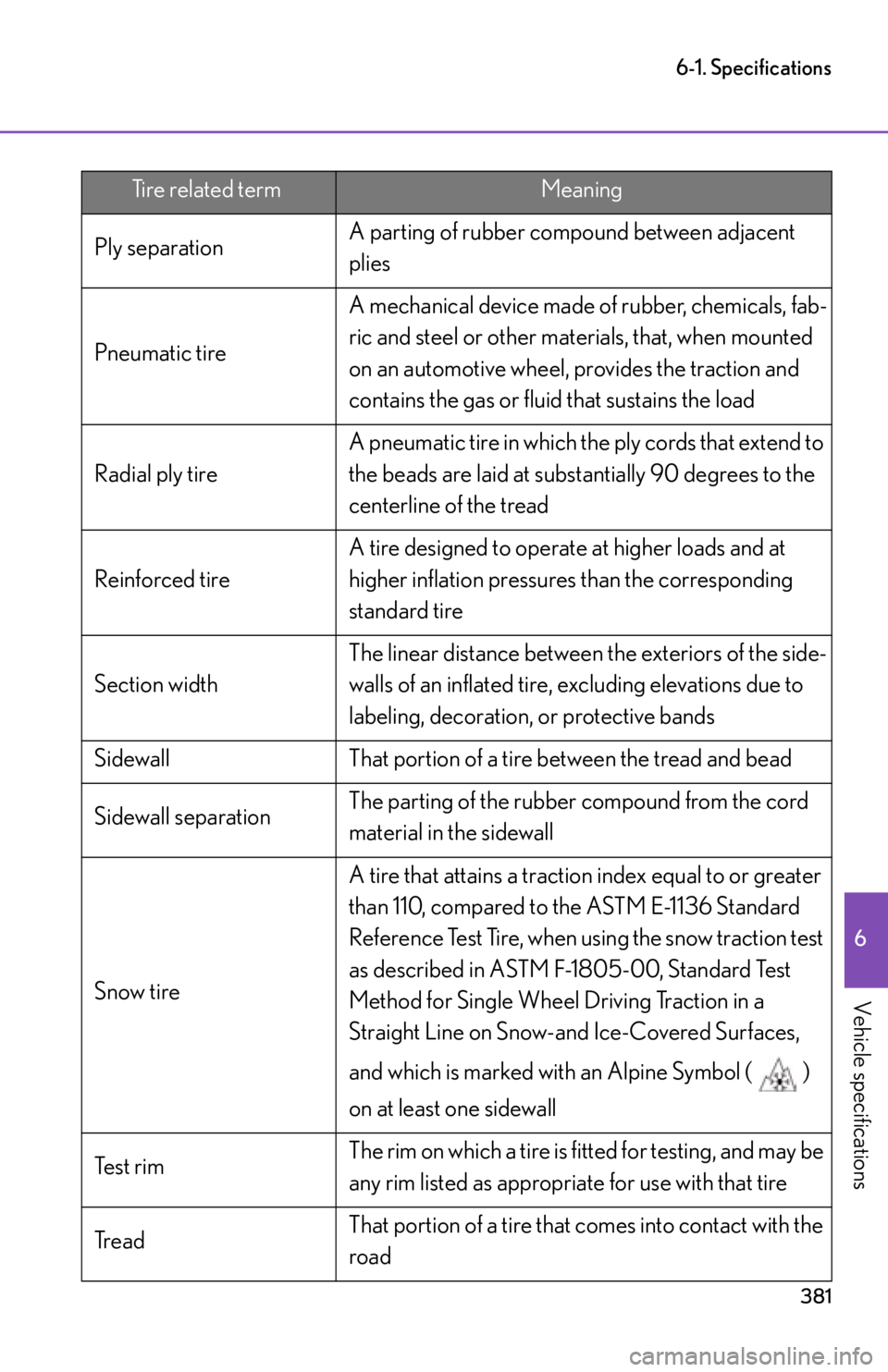Page 358 of 420
356
5-2. Steps to take in an emergency
CAUTION
■If the engine has to be turned off while driving
●If the engine is turned off, the power assist for the brakes and steering may not
function, making braking and steering more difficult. Decelerate as much as pos-
sible before turning off the engine.
●Never attempt to remove the key, as doing so will lock the steering wheel.
Page 367 of 420
365
6-1. Specifications
6
Vehicle specifications
Steering
NOTICE
■Precaution for CCM (Carbon Ceramic Material) brake discs
Be careful not to subject the CCM brake discs to any kind of strong impact.
Even if there is no obvious damage, in the following situations, have the vehicle
inspected by your Lexus dealer:
●If the vehicle is involved in an accident that may affect the suspension and wheels
●If a CCM brake disc sustains an impact during the removal or installation of the
wheels
●If the brake pads have worn out and the metal part of the pad is in contact with the
CCM brake disc surface
Free playLess than 0.6 in. (15 mm)
Page 368 of 420
366
6-1. Specifications
Tires and wheels
Ti r e s i z e265/35ZR20 (95Y), 305/30ZR20 (99Y)
Front and rear tire inflation pres-
sure
(Recommended cold tire inflation
pressure) Front:
33 psi (230 kPa, 2.3 kgf/cm
2 or bar)
Rear: 33 psi (230 kPa, 2.3 kgf/cm
2 or bar)
Driving at high speeds (above 155 mph [250
km/h]) (in countries where such speeds are
permitted by law) Add 8 psi (50 kPa, 0.5 kgf/cm
2 or bar) to the
front tires and rear tires. Never exceed the
maximum cold tire inflation pressure indicated
on the tire sidewall.
Wheel size Front: 20
9 1 /2J
Rear: 20 11 1 /2J
Wheel bolt torque 81 ft•lbf (110 N•m, 11.2 kgf•m)
Page 375 of 420
373
6-1. Specifications
6
Vehicle specifications
Tire size■ Typical tire size information
The illustration indicates typical tire size.
Section width (millimeters)
Aspect ratio
(tire height to section width)
Speed category (alphabet with
one letter)
Tire construction code
(R = Radial, D = Diagonal)
Wheel diameter (inches)
Load index (2 digits or 3 digits)
Speed symbol
(alphabet with one letter)
■ Tire dimensions
Section width
Ti r e h e i g h t
Wheel diameter
Page 378 of 420

376
6-1. Specifications
■Traction AA, A, B, C
The traction grades, from highest to lowest, are AA, A, B and C, and
they represent the tire's ability to stop on wet pavement as measured
under controlled condit ions on specified government test surfaces of
asphalt and concrete.
A tire marked C may have poor traction performance.
Warning: The traction grade assigned to this tire is based on braking
(straight ahead) traction tests and does not include cornering (turning) trac-
tion.
■ Temperature A, B, C
The temperature grades are A (the highest), B, and C, representing
the tire's resistance to the generation of heat and its ability to dissipate
heat when tested under controlled conditions on a specified indoor
laboratory test wheel.
Sustained high temperature can cause the material of the tire to degenerate
and reduce tire life, and excessive temperature can lead to sudden tire fail-
ure.
The grade C corresponds to a level of performance which all passenger car
tires must meet under the Federal Mo tor Vehicle Safety Standard No. 139.
Grades B and A represent higher levels of performance on the laboratory
test wheel than the minimum required by law.
Warning: The temperature grades for this tire are established for a tire that
is properly inflated and not overloaded.
Excessive speed, underinflation, or excess ive loading, either separately or in
combination, can cause heat buildup and possible tire failure.
Page 380 of 420

378
6-1. Specifications
Vehicle capacity weight
(Total load capacity)The rated cargo and luggage load plus 150 lb. (68
kg) times the vehicle's designated seating capacity
Occupant distribution Distribution of occupants in a vehicle as specified in
the third column of Table 1
* below
Recommended inflation
pressure Cold tire inflation pressure recommended by a man-
ufacturer.
Rim A metal support for a tire or a tire and tube assembly
upon which the tire beads are seated
Rim diameter
(Wheel diameter) Nominal diameter of the bead seat
Rim size designation Rim diameter and width
Rim type designation The industry manufacturer's designation for a rim by
style or code
Rim width Nominal distan ce between rim flanges
Vehicle maximum load on
the tire The load on an individual tire that is determined by
distributing to each axle its share of the maximum
loaded vehicle weight, and dividing by two
Vehicle normal load on
the tire The load on an individual tire that is determined by
distributing to each axle its share of curb weight,
accessory weight, and normal occupant weight (dis-
tributed in accordance with Table 1
* below), and
dividing by two
We a t h e r s i d e The surface area of the rim not covered by the
inflated tire
Bead The part of the tire that is made of steel wires,
wrapped or reinforced by ply cords and that is
shaped to fit the rim
Bead separation A breakdown of the bond between components in
the bead
Tire related termMeaning
Page 383 of 420

381
6-1. Specifications
6
Vehicle specifications
Ply separationA parting of rubber comp
ound between adjacent
plies
Pneumatic tire A mechanical device made of rubber, chemicals, fab-
ric and steel or other mate
rials, that, when mounted
on an automotive wheel, provides the traction and
contains the gas or fluid that sustains the load
Radial ply tire A pneumatic tire in which the ply cords that extend to
the beads are laid at substantially 90 degrees to the
centerline of the tread
Reinforced tire A tire designed to operate at higher loads and at
higher inflation pressures than the corresponding
standard tire
Section width The linear distance between the exteriors of the side-
walls of an inflated tire, excluding elevations due to
labeling, decoration, or protective bands
Sidewall That portion of a tire between the tread and bead
Sidewall separation The parting of the rubber
compound from the cord
material in the sidewall
Snow tire A tire that attains a traction index equal to or greater
than 110, compared to the ASTM E-1136 Standard
Reference Test Tire, when using the snow traction test
as described in ASTM F-1805-00, Standard Test
Method for Single Wheel Driving Traction in a
Straight Line on Snow-and Ice-Covered Surfaces,
and which is marked with an Alpine Symbol (
)
on at least one sidewall
Te s t r i m The rim on which a tire is fitted for testing, and may be
any rim listed as appropriate for use with that tire
Tr e a d That portion of a tire that comes into contact with the
road
Tire related termMeaning
Page 384 of 420
382
6-1. Specifications
*: Table 1 Occupant loading and distribution for vehicle normal load for
various designated seating capacities
Tr e a d r i b A tread section running circumferentially around a
tire
Tread separation Pulling away of the tread from the tire carcass
Treadwear indicators
(TWI) The projections within the principal grooves
designed to give a visual indication of the degrees of
wear of the tread
Wheel-holding fixture The fixture used to hold the wheel and tire assembly
securely during testing
Designated seating
capacity, Number of occupantsVehicle normal load,
Number of occupantsOccupant distribution in
a normally loaded vehicle
2 through 4 2 2 in front
5 through 10 3 2 in front, 1 in second seat
11 through 15 5 2 in front, 1 in second
seat, 1 in third seat, 1 in fourth seat
16 through 20 7 2 in front, 2 in second
seat, 2 in third seat, 1 in
fourth seat
Tire related termMeaning